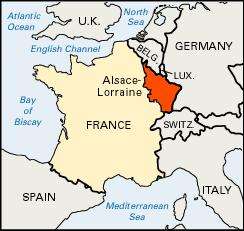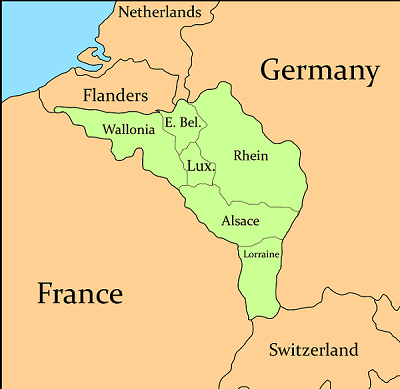ALSACE-LORRAINE and LUXEMBOURG
Alsace-Lorraine (German Elsass-Lothringen) is an area comprising the present French départements of Haut-Rhin, Bas-Rhin, and Moselle. Alsace-Lorraine was the name given to the 5,067 square miles of territory that was ceded by France to Germany in 1871 after the Franco-German War. This territory was retroceded to France in 1919 after World War I, was ceded again to Germany in 1940 during World War II, and was again retroceded to France in 1945.

Because of its ancient German associations and because of its large German-speaking population, Alsace-Lorraine was incorporated into the German Empire after France’s defeat in the Franco-German War (1870–71). The loss of Alsace-Lorraine was a major cause of anti-German feeling in France in the period from 1871 to 1914. France also suffered economically from the loss of Alsace-Lorraine’s valuable iron ore deposits, iron- and steelmaking plants, and other industries to Germany.
Under German rule, Alsace-Lorraine was classified as a Reichsland (imperial state) and was denied effective self-government until 1902. Moreover, its population was initially enthusiastic over the new French republic, and German rule remained unpopular for some years among the inhabitants, who continued to protest the German annexation. Thousands of residents who considered themselves French emigrated during this period.
By 1905, however, many of Alsace-Lorraine’s Roman Catholics had been alienated by the French republic’s anticlerical policies, and so they shifted their aspirations toward an autonomous Alsace-Lorraine within the German Empire. Thereafter, especially with the grant of a constitution in 1911, some progress was made toward Germanization in the region.
Alsace-Lorraine was returned to France in 1919 after World War I. The French government’s attempts to rapidly assimilate Alsace-Lorraine met with problems, however, especially in France’s plans to substitute state-run schools for the region’s traditional church schools and in its attempts to suppress German newspapers (German being the written language of 75 percent of the inhabitants). As a consequence, Alsace-Lorraine developed a strong “home rule” movement in the 1920s and unsuccessfully sought autonomy within the French Republic.
Early in World War II, the collapse of France in 1940 was followed by the second German annexation of Alsace-Lorraine, which was again returned to France in 1945. Since then many of the French prewar governmental policies that had clashed with the region’s particularism have been modified, and the autonomist movement has largely disappeared. Linguistically, the German dialect known as Alsatian remains the lingua franca of the region, and both French and German are taught in the schools.
Luxembourg, officially the Grand Duchy of Luxembourg, is a small landlocked country in western Europe. It is bordered by Belgium to the west and north, Germany to the east, and France to the south. Its capital, Luxembourg City, together with Brussels and Strasbourg, is one of the three official capitals of the European Union and the seat of the European Court of Justice, the highest judicial authority in the EU. Its culture, people, and languages are highly intertwined with its neighbours, making it essentially a mixture of French and German cultures, as evident by the nation's three official languages: French, German, and the national language, Luxembourgish (sometimes considered a dialect of German). The repeated invasions by Germany, especially in World War II, resulted in the country's strong will for mediation between France and Germany and, among other things, led to the foundation of the European Union.

With an area of 2,586 square kilometres (998 sq mi), it is one of the smallest sovereign states in Europe. In 2016, Luxembourg had a population of 576,249, which makes it one of the least-populous countries in Europe, but by far the one with the highest population growth rate. Foreigners account for nearly half of Luxembourg's population. As a representative democracy with a constitutional monarch, it is headed by Grand Duke Henri and is the world's only remaining grand duchy. Luxembourg is a developed country, with an advanced economy and one of the world's highest GDP (PPP) per capita. The City of Luxembourg with its old quarters and fortifications was declared a UNESCO World Heritage Site in 1994 due to the exceptional preservation of the vast fortifications and the old city.
The history of Luxembourg is considered to begin in 963, when count Siegfried I acquired a rocky promontory and its Roman-era fortifications known as Lucilinburhuc, 'little castle', and the surrounding area from the Imperial Abbey of St. Maximin in nearby Trier. Siegfried's descendants increased their territory through marriage, war and vassal relations. At the end of the 13th century, the Counts of Luxembourg reigned over a considerable territory. In 1308, Henry VII, Count of Luxembourg became King of the Germans and Holy Roman Emperor. The House of Luxembourg produced four Holy Roman Emperors at the high time of the Middle Ages. In 1354, Charles IV elevated the County to the Duchy of Luxembourg. Since Sigismund had no male heir, the Duchy became part of the Burgundian Circle and then one of the Seventeen Provinces of the Habsburg Netherlands. Over the centuries, the City and Fortress of Luxembourg, of great strategic importance situated between the Kingdom of France and the Habsburg territories, was gradually built up to be one of the most reputed fortifications in Europe. After belonging to both the France of Louis XIV and the Austria of Maria Theresia, Luxembourg became part of the First French Republic and Empire under Napoleon.
The present-day state of Luxembourg first emerged at the Congress of Vienna in 1815. The Grand-Duchy, with its powerful fortress, became an independent state under the personal possession of William I of the Netherlands with a Prussian garrison to guard the city against another invasion from France. In 1839, following the turmoil of the Belgian Revolution, the purely Oil-speaking part of Luxembourg was ceded to Belgium and the Luxembourgish-speaking part (except the Arelerland, the area around Arlon) became what is the present state of Luxembourg.
Luxembourg is a founding member of the European Union, OECD, United Nations, NATO, and Benelux. The city of Luxembourg, which is the country's capital and largest city, is the seat of several institutions and agencies of the EU. Luxembourg served on the United Nations Security Council for the years 2013 and 2014, which was a first in the country's history. In 2016 Luxembourgish citizens had visa-free or visa-on-arrival access to 172 countries and territories, ranking the Luxembourgish passport 15th in the world, tied with countries such as Canada and Switzerland.